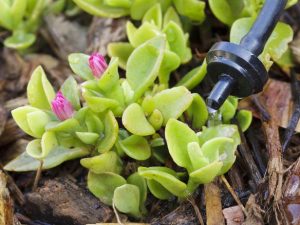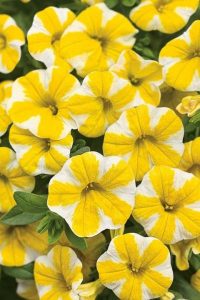 Once again our spring planting season is moving into full swing! As gardeners are putting new plants into the ground the question most asked at the garden center this week has been, “When do I turn on the water?” The answer is simple: Our growing season is from April though October and irrigation systems should be activated during this time.
Once again our spring planting season is moving into full swing! As gardeners are putting new plants into the ground the question most asked at the garden center this week has been, “When do I turn on the water?” The answer is simple: Our growing season is from April though October and irrigation systems should be activated during this time.
Here are the watering practices I have used over the years: This week I just set my irrigation clocks to water trees and shrubs once every 7 to 10 days. In June the weather heats up so that is when, delivering the same volume of water, I bump up frequency to every 5 to 7 days. The key to efficient, effective use of water is occasional long, deep irrigation rather than a more frequent and shallow watering. A drip system should run for 2 – 3 hours at a time to properly penetrate a plant’s entire root zone.
As I said, these are just guidelines but they provide a good starting point. They seem to work well with heavy soils, but you might need to increase the frequency if you live in areas out towards Granite Mountain or if you garden in faster draining soils. Because water requirements are contingent upon the soil bands going through each yard, these are only general guidelines. Ultimately, your yard will be slightly different from anyone else’s. Even your back yard can be different from the front yard!
For years now, I have been in the habit of taking a morning stroll through my garden just to keep tabs on how things are growing and monitor soils so that irrigation can be adjusted to the best schedule. A simple visual inspection can be tricky because the soil surface can be dry and crusty while the soil just a few inches deeper can be wet. A water meter is a handy and sure way to test soil moisture five inches below the surface. I found a really good digital meter, Rapitest with moisture probe, to use on my houseplants and in the landscape. Although it is specialized, it’s a simple tool carried by most garden centers.
Also useful is the excellent, but compact, water guide I created that is sized to tape inside the cover of an irrigation timer. This simple guide instructs on both the summer and winter suggested irrigation schedules. It’s at Watters free for the asking.
~~ ~~ ~~ ~~ ~~ ~~ ~~
Aqua Boost Crystals – These are polymer crystals that hold 200 times their weight in water right at the root level and then release moisture back to the plant during the heat of the day. They easily double the length of time a gardener can go between irrigation cycles. Even better, the crystals have been laced with seven different beneficial mycorrhizae fungi that stimulate plants to root into their surrounding soils. What we have is a soil additive that holds water at the root level and promotes deeper roots! I find it so helpful that, as I plant it, every plant in my raised beds and container gardens gets a generous dose of these crystals.
~~ ~~ ~~ ~~ ~~ ~~ ~~
GARDEN ALERT! Local gardeners have begun bringing pine scale samples into the garden center. This annual scourge has taught us to treat pines right away. Scale is such a problem that we created a bug control specifically to combat this pest; it’s called “Plant Protector”. It is so easy to use that anyone, working alone, can treat several large trees; yet it is so effective that one application is effective for an entire year. I received the inside scoop from the scientist that created this fabulous product, so I know exactly how to use it. Feel free to stop by the garden center for detailed instructions on how to use this liquid to prevent scale on your pines.
~~ ~~ ~~ ~~ ~~ ~~ ~~
 Plant of the Week is the Lemon Spice Calibrachoa. The new pinwheel pattern of lemon-and-white flowers is a stylish accent that grows fast and thrives in full sun. Producing hundreds of petunia-shaped flowers, it’s perfect for hanging baskets and raised beds. Each fragrant plant spreads an impressive 24” across. Best of all, this new variety cleans itself for easy care and constant blooms! Most of us know calibrachoa as a family of plants that produces striking mountain blooms, so make sure to check out this one with its lemony-stripe patterned flowers.
Plant of the Week is the Lemon Spice Calibrachoa. The new pinwheel pattern of lemon-and-white flowers is a stylish accent that grows fast and thrives in full sun. Producing hundreds of petunia-shaped flowers, it’s perfect for hanging baskets and raised beds. Each fragrant plant spreads an impressive 24” across. Best of all, this new variety cleans itself for easy care and constant blooms! Most of us know calibrachoa as a family of plants that produces striking mountain blooms, so make sure to check out this one with its lemony-stripe patterned flowers.
Until next week, I’ll see you in the garden center.

